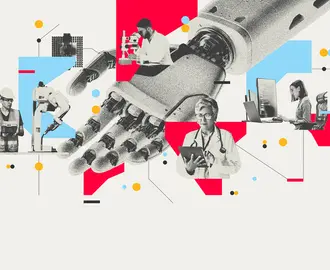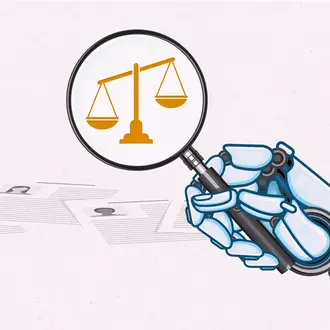Credit: FGC / Shutterstock
New book explores how AI really changes the way we work
One of the earliest predictions about artificial intelligence was that robots would steal jobs from people, particularly for seemingly monotonous and menial tasks.
Case in point: Flippy 2, the “autonomous robotic kitchen assistant” developed by Miso Robotics to turn hamburgers as they cook. The restaurant chain CaliBurger is testing Flippy at various locations. But what the robot is best at doing isn’t what it was designed to do.
“[A CaliBurger franchise owner] said, ‘Flippy isn’t actually as good as I might have liked at flipping hamburgers, but it’s pretty good at pulling baskets of French fries out when they’re done,’” said Thomas Davenport, a digital fellow at the MIT Initiative on the Digital Economy. “We've known for a while that AI and robots might take the jobs of burger flippers — but it hasn't happened yet.”
Davenport’s new book, “Working With AI: Real Stories of Human-Machine Collaboration,” looks at 29 examples of humans working with AI-enabled systems, showing when and how AI works best and how companies can use AI responsibly. The book is co-authored by Singapore Management University professor Steven M. Miller.
The common theme is that AI is augmenting the work that humans do, not fully automating it. That means many jobs are safe, Davenport said during a recent webinar hosted by the MIT Sloan Management Review.
“One of our major conclusions is [augmentation] doesn’t appear to result in job loss,” Davenport said.
Davenport and Miller outlined how companies are implementing AI to the best advantage:
AI works best in “normal” conditions
Miller defined automation as a process in which a machine completes enough tasks that the human who was previously doing them is effectively displaced. Augmentation, on the other hand, is the automation of smaller tasks, not an entire job.
“The human stays involved in direct execution,” Miller said.
This distinction is important, and it helps to explain scenarios when organizations would look to use one or the other.
“AI is great at operating a machine under what we think of as normal conditions. Under expected circumstances, AI is really good at keeping things going,” Davenport said.
One example is looking for keywords in lengthy documents such as legal contracts or health records and producing results in seconds. Another is monitoring information from thousands or even millions of sources, whether sensors on a manufacturing floor or cybersecurity monitoring tools. These types of processes can be labor-intensive for humans but are easy for machines.
“Full automation works really well when you're in familiar territories and when the nature of variance and the nature of the unexpected is somewhat familiar. You can really drive for that efficiency, consistency, optimization, and productivity,” Miller said.
Of course, conditions are rarely normal enough for AI to run without human intervention. That’s why Flippy needs an experienced cook to know which part of the grill is the hot spot that cooks burgers faster. That’s why the robotic weed-puller developed by agtech company FarmWise still needs a farmer walking behind it to make sure the plant it’s clutching isn’t a vegetable. (Though this still beats the historic technique of spraying dangerous chemicals over the entire crop to kill the weeds.)
That’s why autonomous vehicles work well in the dry air of Las Vegas or Phoenix but haven’t made their way to rainy or snowy climates.
“I dread the day that they come to Boston in the middle of the winter,” Davenport said.
4 situations when AI augmentation makes sense
The concept of augmentation is hardly new. Humans started using stone tools thousands of years ago. It’s also familiar to knowledge workers who no longer need a calculator on their desks.
“Anybody who’s used a spreadsheet understands the power of augmentation,” Miller said.
Still, augmentation enabled by AI is often underappreciated in today’s enterprises.
“There are more opportunities than people assume,” Miller said.
Davenport and Miller provided examples that fit into four broad and overlapping categories:
- When companies want to experiment. Product development is especially expensive in the pharmaceutical industry, where the median R&D cost for new drugs is now north of $1 billion. Instead of spending up to a year working on a drug only to realize that it’s not going to work, pharma manufacturers are creating AI infrastructure to assess their data and evaluate potential use cases for a new drug in as little as two weeks, Davenport said. Not only does this support frontline workers, it also leads to new “data product” roles to manage these AI use cases.
- When there’s a lot of pencil-pushing. “Every businessperson we meet, and any company we talk to, almost always has the same lament: ‘We have so much to do, and we don't have the headcount to do it.’ At the same time, they complain about how much grunt work they have to do,” Miller said. In these situations, he added, automation will free up employees to do more of the experimental work augmented by AI, from product development to predictive analytics.
- When things are happening quickly. Cybersecurity monitoring software can assess threats from millions of sources in real time. Some tools can also prioritize threats and even automatically respond to them — by shutting down a compromised device, for example. But in “complicated and nuanced cases,” Miller said it takes an experienced security analyst to assess all the data collected and determine whether something is a one-off incident or an indication of a pattern of attacks that may require mitigation on a larger scale.
- When workers want a recommendation. When consumers put their trust in health care professionals, augmentation acts as form of decision support. For example, AI looks at the available information and makes a recommendation, but the final decision is up to the doctor in front of the computer. In countries such as China and Indonesia, where hundreds of millions of patients have access to AI-powered diagnostic tools such as Ping An Good Doctor, “A physician actually has to produce the diagnosis and the treatment, or else it’s not valid,” Davenport said. “But the AI system does save the doctor a lot of time and effort.”
How to work with AI in responsible ways
Moving ahead with AI augmentation means accepting that machines are better than humans at some tasks.
Again, this concept isn’t new. “We’ve always had super tools. We have jet airplanes, we have cars, we have power shovels and cranes,” Miller said. “Now we have super tools that can do non-routine, cognitive-oriented things.”
Related Articles
At the same time, machines can’t bring in all the dimensions of intelligence. Citing the theory of adaptive intelligence from Robert J. Sternberg of Cornell University, Miller said the human mind is particularly suited for creativity, wisdom, and context — not just realizing that something can be done, but whether it should be done. In other words, don’t underestimate what humans can do.
The most effective and responsible use cases for AI augmentation are more than rudimentary tasks or job automation. The goal should be to bring humans and machines together to achieve a level of intelligence higher than what a human or a machine could achieve on its own, Miller said. The whole should be greater than the sum of its parts.
In doing this, enterprises can expect to create new types of products and services, as well as new types of work. But this comes with two clear caveats: Workers need the right skills to use AI systems, and they need to see that AI is helping them and not going to replace them.
“We really need to step up and help people adapt to some of these new tools,” Davenport said. “We need to retrain workers and engage them in this new type of work.”
Read next: Sec’s Gary Gensler on how AI is changing finance



